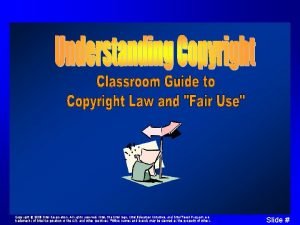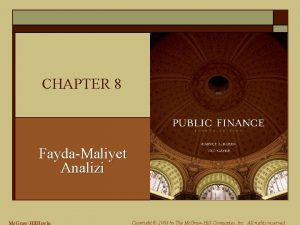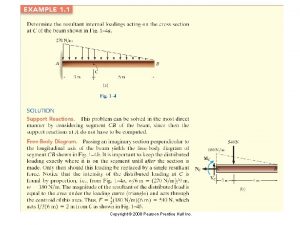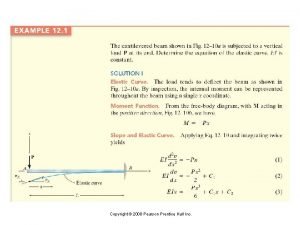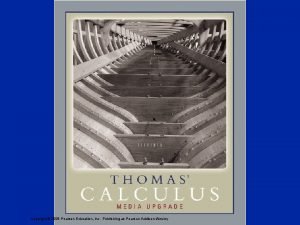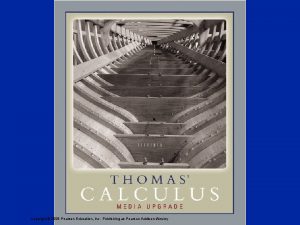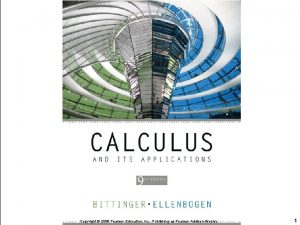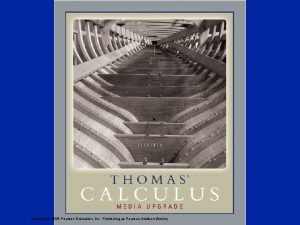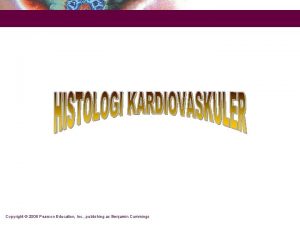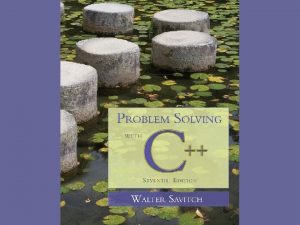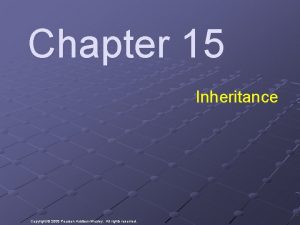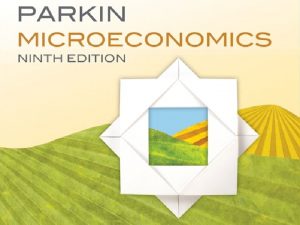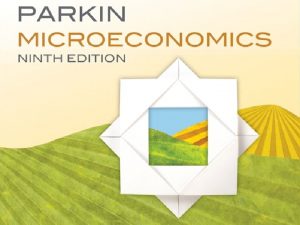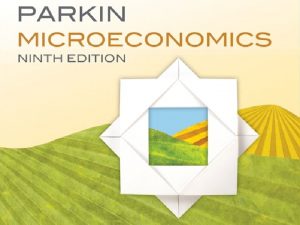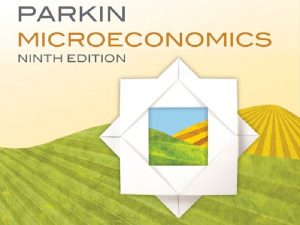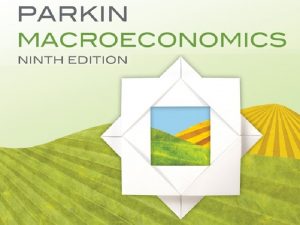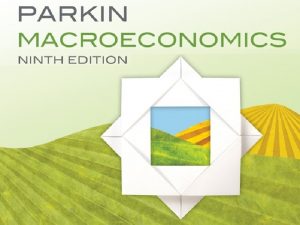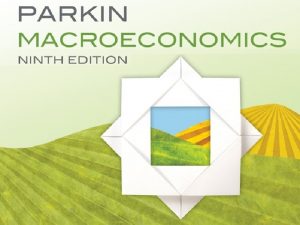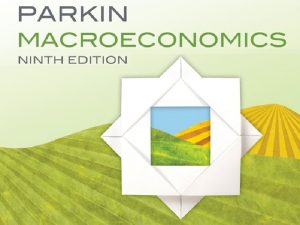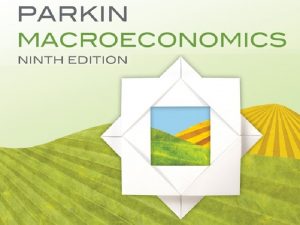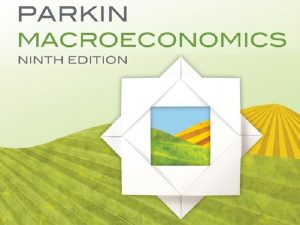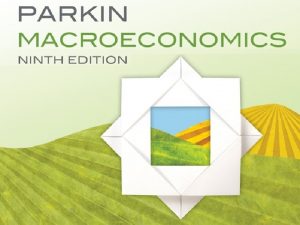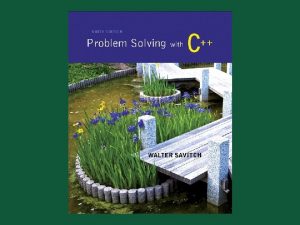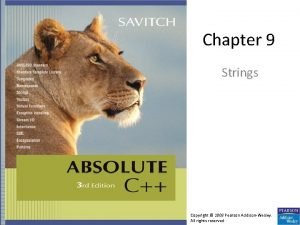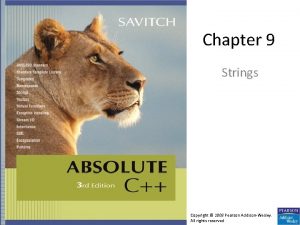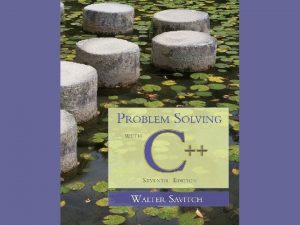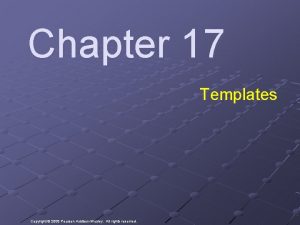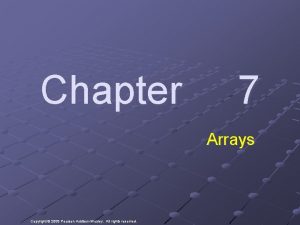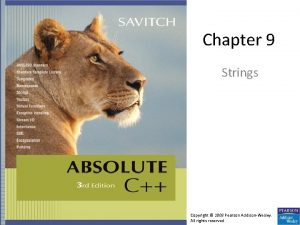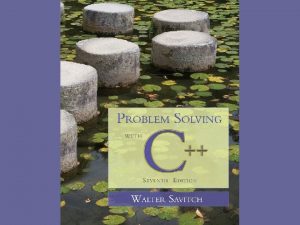Chapter 14 Inheritance Copyright 2008 Pearson AddisonWesley All






































- Slides: 38

Chapter 14 Inheritance Copyright © 2008 Pearson Addison-Wesley. All rights reserved

Learning Objectives • Inheritance Basics – – Derived classes, with constructors protected: qualifier Redefining member functions Non-inherited functions • Programming with Inheritance – Assignment operators and copy constructors – Destructors in derived classes – Multiple inheritance Copyright © 2008 Pearson Addison-Wesley. All rights reserved. 14 -2

Introduction to Inheritance • Object-oriented programming – Powerful programming technique – Provides abstraction dimension called inheritance • General form of class is defined – Specialized versions then inherit properties of general class – And add to it/modify it’s functionality for it’s appropriate use Copyright © 2008 Pearson Addison-Wesley. All rights reserved. 14 -3

Inheritance Basics • New class inherited from another class • Base class – "General" class from which others derive • Derived class – New class – Automatically has base class’s: • Member variables • Member functions – Can then additional member functions and variables Copyright © 2008 Pearson Addison-Wesley. All rights reserved. 14 -4

Derived Classes • Consider example: Class of "Employees" • Composed of: – Salaried employees – Hourly employees • Each is "subset" of employees – Another might be those paid fixed wage each month or week Copyright © 2008 Pearson Addison-Wesley. All rights reserved. 14 -5

Derived Classes • Don’t "need" type of generic "employee" – Since no one’s just an "employee" • General concept of employee helpful! – All have names – All have social security numbers – Associated functions for these "basics" are same among all employees • So "general" class can contain all these "things" about employees Copyright © 2008 Pearson Addison-Wesley. All rights reserved. 14 -6

Employee Class • Many members of "employee" class apply to all types of employees – Accessor functions – Mutator functions – Most data items: • SSN • Name • Pay • We won’t have "objects" of this class, however Copyright © 2008 Pearson Addison-Wesley. All rights reserved. 14 -7

Employee Class • Consider print. Check() function: – Will always be "redefined" in derived classes – So different employee types can have different checks – Makes no sense really for "undifferentiated" employee – So function print. Check() in Employee class says just that • Error message stating "print. Check called for undifferentiated employee!! Aborting…" Copyright © 2008 Pearson Addison-Wesley. All rights reserved. 14 -8

Deriving from Employee Class • Derived classes from Employee class: – Automatically have all member variables – Automatically have all member functions • Derived class said to "inherit" members from base class • Can then redefine existing members and/or add new members Copyright © 2008 Pearson Addison-Wesley. All rights reserved. 14 -9

Display 14. 3 Interface for the Derived Class Hourly. Employee (1 of 2) Copyright © 2008 Pearson Addison-Wesley. All rights reserved. 14 -10

Display 14. 3 Interface for the Derived Class Hourly. Employee (2 of 2) Copyright © 2008 Pearson Addison-Wesley. All rights reserved. 14 -11

Hourly. Employee Class Interface • Note definition begins same as any other – #ifndef structure – Includes required libraries – Also includes employee. h! • And, the heading: class Hourly. Employee : public Employee {… – Specifies "publicly inherited" from Employee class Copyright © 2008 Pearson Addison-Wesley. All rights reserved. 14 -12

Hourly. Employee Class Additions • Derived class interface only lists new or "to be redefined" members – Since all others inherited are already defined – i. e. : "all" employees have ssn, name, etc. • Hourly. Employee adds: – Constructors – wage. Rate, hours member variables – set. Rate(), get. Rate(), set. Hours(), get. Hours() member functions Copyright © 2008 Pearson Addison-Wesley. All rights reserved. 14 -13

Hourly. Employee Class Redefinitions • Hourly. Employee redefines: – print. Check() member function – This "overrides" the print. Check() function implementation from Employee class • It’s definition must be in Hourly. Employee class’s implementation – As do other member functions declared in Hourly. Employee’s interface • New and "to be redefined" Copyright © 2008 Pearson Addison-Wesley. All rights reserved. 14 -14

Inheritance Terminology • Common to simulate family relationships • Parent class – Refers to base class • Child class – Refers to derived class • Ancestor class – Class that’s a parent of a parent … • Descendant class – Opposite of ancestor Copyright © 2008 Pearson Addison-Wesley. All rights reserved. 14 -15

Constructors in Derived Classes • Base class constructors are NOT inherited in derived classes! – But they can be invoked within derived class constructor • Which is all we need! • Base class constructor must initialize all base class member variables – Those inherited by derived class – So derived class constructor simply calls it • "First" thing derived class constructor does Copyright © 2008 Pearson Addison-Wesley. All rights reserved. 14 -16

Derived Class Constructor Example • Consider syntax for Hourly. Employee constructor: Hourly. Employee: : Hourly. Employee(string the. Name, string the. Number, double the. Wage. Rate, double the. Hours) : Employee(the. Name, the. Number), wage. Rate(the. Wage. Rate), hours(the. Hours) { //Deliberately empty } • Portion after : is "initialization section" – Includes invocation of Employee constructor Copyright © 2008 Pearson Addison-Wesley. All rights reserved. 14 -17

Another Hourly. Employee Constructor • A second constructor: Hourly. Employee: : Hourly. Employee() : Employee(), wage. Rate(0), hours(0) { //Deliberately empty } • Default version of base class constructor is called (no arguments) • Should always invoke one of the base class’s constructors Copyright © 2008 Pearson Addison-Wesley. All rights reserved. 14 -18

Constructor: No Base Class Call • Derived class constructor should always invoke one of the base class’s constructors • If you do not: – Default base class constructor automatically called • Equivalent constructor definition: Hourly. Employee: : Hourly. Employee() : wage. Rate(0), hours(0) {} Copyright © 2008 Pearson Addison-Wesley. All rights reserved. 14 -19

Pitfall: Base Class Private Data • Derived class "inherits" private member variables – But still cannot directly access them – Not even through derived class member functions! • Private member variables can ONLY be accessed "by name" in member functions of the class they’re defined in Copyright © 2008 Pearson Addison-Wesley. All rights reserved. 14 -20

Pitfall: Base Class Private Member Functions • Same holds for base class member functions – Cannot be accessed outside interface and implementation of base class – Not even in derived class member function definitions Copyright © 2008 Pearson Addison-Wesley. All rights reserved. 14 -21

Pitfall: Base Class Private Member Functions Impact • Larger impact here vs. member variables – Member variables can be accessed indirectly via accessor or mutator member functions – Member functions simply not available • This is "reasonable" – Private member functions should be simply "helper" functions – Should be used only in class they’re defined Copyright © 2008 Pearson Addison-Wesley. All rights reserved. 14 -22

The protected: Qualifier • New classification of class members • Allows access "by name" in derived class – But nowhere else – Still no access "by name" in other classes • In class it’s defined acts like private • Considered "protected" in derived class – To allow future derivations • Many feel this "violates" information hiding Copyright © 2008 Pearson Addison-Wesley. All rights reserved. 14 -23

Redefinition of Member Functions • Recall interface of derived class: – Contains declarations for new member functions – Also contains declarations for inherited member functions to be changed – Inherited member functions NOT declared: • Automatically inherited unchanged • Implementation of derived class will: – Define new member functions – Redefine inherited functions as declared Copyright © 2008 Pearson Addison-Wesley. All rights reserved. 14 -24

Redefining vs. Overloading • Very different! • Redefining in derived class: – SAME parameter list – Essentially "re-writes" same function • Overloading: – Different parameter list – Defined "new" function that takes different parameters – Overloaded functions must have different signatures Copyright © 2008 Pearson Addison-Wesley. All rights reserved. 14 -25

A Function’s Signature • Recall definition of a "signature": – Function’s name – Sequence of types in parameter list • Including order, number, types • Signature does NOT include: – Return type – const keyword –& Copyright © 2008 Pearson Addison-Wesley. All rights reserved. 14 -26

Accessing Redefined Base Function • When redefined in derived class, base class’s definition not "lost" • Can specify it’s use: Employee Jane. E; Hourly. Employee Sally. H; Jane. E. print. Check(); calls Employee’s print. Check function Sally. H. print. Check(); calls Hourly. Employee print. Check function Sally. H. Employee: : print. Check(); Calls Employee’s print. Check function! • Not typical here, but useful sometimes Copyright © 2008 Pearson Addison-Wesley. All rights reserved. 14 -27

Functions Not Inherited • All "normal" functions in base class are inherited in derived class • Exceptions: – Constructors (we’ve seen) – Destructors – Copy constructor • But if not defined, generates "default" one • Recall need to define one for pointers! – Assignment operator • If not defined default Copyright © 2008 Pearson Addison-Wesley. All rights reserved. 14 -28

Assignment Operators and Copy Constructors • Recall: overloaded assignment operators and copy constructors NOT inherited – But can be used in derived class definitions – Typically MUST be used! – Similar to how derived class constructor invokes base class constructor Copyright © 2008 Pearson Addison-Wesley. All rights reserved. 14 -29

Assignment Operator Example • Given "Derived" is derived from "Base": Derived& Derived: : operator =(const Derived & right. Side) { Base: : operator =(right. Side); … } • Notice code line – Calls assignment operator from base class • This takes care of all inherited member variables – Would then set new variables from derived class… Copyright © 2008 Pearson Addison-Wesley. All rights reserved. 14 -30

Copy Constructor Example • Consider: Derived: : Derived(const Derived& Object) : Base(Object), … {…} • After : is invocation of base copy constructor – Sets inherited member variables of derived class object being created – Note Object is of type Derived; but it’s also of type Base, so argument is valid Copyright © 2008 Pearson Addison-Wesley. All rights reserved. 14 -31

Destructors in Derived Classes • If base class destructor functions correctly – Easy to write derived class destructor • When derived class destructor is invoked: – Automatically calls base class destructor! – So no need for explicit call • So derived class destructors need only be concerned with derived class variables – And any data they "point" to – Base class destructor handles inherited data automatically Copyright © 2008 Pearson Addison-Wesley. All rights reserved. 14 -32

Destructor Calling Order • Consider: class B derives from class A class C derives from class B A B C • When object of class C goes out of scope: – Class C destructor called 1 st – Then class B destructor called – Finally class A destructor is called • Opposite of how constructors are called Copyright © 2008 Pearson Addison-Wesley. All rights reserved. 14 -33

"Is a" vs. "Has a" Relationships • Inheritance – Considered an "Is a" class relationship – e. g. , An Hourly. Employee "is a" Employee – A Convertible "is a" Automobile • A class contains objects of another class as it’s member data – Considered a "Has a" class relationship – e. g. , One class "has a" object of another class as it’s data Copyright © 2008 Pearson Addison-Wesley. All rights reserved. 14 -34

Protected and Private Inheritance • New inheritance "forms" – Both are rarely used • Protected inheritance: class Salaried. Employee : protected Employee {…} – Public members in base class become protected in derived class • Private inheritance: class Salaried. Employee : private Employee {…} – All members in base class become private in derived class Copyright © 2008 Pearson Addison-Wesley. All rights reserved. 14 -35

Multiple Inheritance • Derived class can have more than one base class! – Syntax just includes all base classes separated by commas: class derived. Multi : public base 1, base 2 {…} • Possibilities for ambiguity are endless! • Dangerous undertaking! – Some believe should never be used – Certainly should only be used be experienced programmers! Copyright © 2008 Pearson Addison-Wesley. All rights reserved. 14 -36

Summary 1 • Inheritance provides code reuse – Allows one class to "derive" from another, adding features • Derived class objects inherit members of base class – And may add members • Private member variables in base class cannot be accessed "by name" in derived • Private member functions are not inherited Copyright © 2008 Pearson Addison-Wesley. All rights reserved. 14 -37

Summary 2 • Can redefine inherited member functions – To perform differently in derived class • Protected members in base class: – Can be accessed "by name" in derived class member functions • Overloaded assignment operator not inherited – But can be invoked from derived class • Constructors are not inherited – Are invoked from derived class’s constructor Copyright © 2008 Pearson Addison-Wesley. All rights reserved. 14 -38
 2008 2008
2008 2008 Copyright 2008
Copyright 2008 Copyright 2008
Copyright 2008 Copyright 2008
Copyright 2008 Copyright 2008
Copyright 2008 2008 pearson prentice hall inc
2008 pearson prentice hall inc Copyright 2008
Copyright 2008 Copyright 2008
Copyright 2008 Pearson education limited 2008
Pearson education limited 2008 2008 pearson prentice hall inc
2008 pearson prentice hall inc 2008 pearson prentice hall inc
2008 pearson prentice hall inc Pearson
Pearson 2008 pearson education inc
2008 pearson education inc 2008 pearson education inc
2008 pearson education inc Pearson education limited 2008
Pearson education limited 2008 Pearson education limited 2008
Pearson education limited 2008 Line item budget example
Line item budget example 2008 pearson education inc
2008 pearson education inc 2008 pearson education inc
2008 pearson education inc 2008 pearson education inc
2008 pearson education inc 2008 pearson education inc
2008 pearson education inc Layers and components of the artery wall
Layers and components of the artery wall Pearson education limited 2008
Pearson education limited 2008 2017 pearson education inc
2017 pearson education inc Copyright pearson education inc
Copyright pearson education inc 2010 pearson education inc
2010 pearson education inc 2009 pearson education inc
2009 pearson education inc 2018 pearson education inc
2018 pearson education inc Copyright 2014 pearson education inc
Copyright 2014 pearson education inc Copyright 2010 pearson education inc
Copyright 2010 pearson education inc Copyright 2010 pearson education inc
Copyright 2010 pearson education inc Copyright by pearson education inc. answers
Copyright by pearson education inc. answers Copyright 2005 pearson prentice hall inc
Copyright 2005 pearson prentice hall inc Copyright 2009 pearson education inc
Copyright 2009 pearson education inc Copyright pearson education inc
Copyright pearson education inc Copyright 2010 pearson education inc
Copyright 2010 pearson education inc Copyright 2010 pearson education inc
Copyright 2010 pearson education inc Copyright 2010 pearson education inc
Copyright 2010 pearson education inc 2010 pearson education inc
2010 pearson education inc


